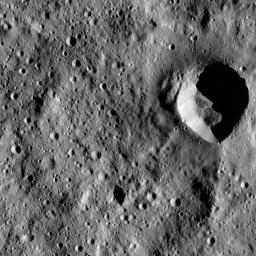
|
Dawn LAMO Image 31
- Click the image above for a larger view
- Full-Res JPEG (1024 x 1024) (234.7 kB)
- Full-Res TIFF (1024 x 1024) (1.1 MB)
Caption:
This image, taken by the framing camera aboard NASA's Dawn spacecraft shows a fresh impact crater with an asymmetric rim. The crater displays a sharp rim over much of its perimeter that is interrupted by a smooth area in the north. The crater is surrounded by a smooth ejecta blanket, and its floor is covered by mass wasting material -- that is, material that has fallen down the steep walls into the crater's interior.
The fresh crater appears to have disrupted the faded rim of a much older, and larger, impact feature. Part of that older crater rim is seen immediately below the fresh crater.
The image is centered at approximately 53.7 degrees south latitude, 332.1 degrees east longitude. Dawn captured the scene on Jan. 6, 2016, from its low-altitude mapping orbit (LAMO), at an altitude of 237 miles (381 kilometers) above Ceres. The image resolution is 102 feet (31 meters) per pixel.
Background Info:
Dawn's mission is managed by JPL for NASA's Science Mission Directorate in Washington. Dawn is a project of the directorate's Discovery Program, managed by NASA's Marshall Space Flight Center in Huntsville, Alabama. UCLA is responsible for overall Dawn mission science. Orbital ATK, Inc., in Dulles, Virginia, designed and built the spacecraft. The German Aerospace Center, the Max Planck Institute for Solar System Research, the Italian Space Agency and the Italian National Astrophysical Institute are international partners on the mission team. For a complete list of acknowledgments, see http://dawn.jpl.nasa.gov/mission .
For more information about the Dawn mission, visit http://dawn.jpl.nasa.gov .
Cataloging Keywords:
| Name | Value | Additional Values |
|---|---|---|
| Target | 1 Ceres | |
| System | Main Belt | |
| Target Type | Dwarf Planet | Asteroid |
| Mission | Dawn | |
| Instrument Host | Dawn | |
| Host Type | Orbiter | |
| Instrument | Framing Camera (FC) | |
| Detector | ||
| Extra Keywords | Crater, Grayscale, Impact | |
| Acquisition Date | ||
| Release Date | 2016-02-22 | |
| Date in Caption | 2016-01-06 | |
| Image Credit | NASA/JPL-Caltech/UCLA/MPS/DLR/IDA | |
| Source | photojournal.jpl.nasa.gov/catalog/PIA20385 | |
| Identifier | PIA20385 | |
